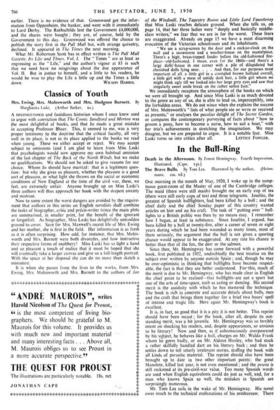Classics of Youth
Mrs. Ewing, Mrs. Molesworth and Mrs. Hodgson Burnett. By Marghanita Laski. (Arthur Barker. 6s.) A DISTINGUISHED and fastidious-historian whom I once knew used to argue with conviction that The Comic Sandford and Merton was the most delightful of books, and that Jo made a great mistake in accepting Professor Bhaer. This, it seemed to me, was a very proper testimony to the doctrine that the critical faculty, all very well in its place, is not in its place applied to the books we read when young. These we either accept or reject. We may accept subject to omissions (and I am glad to learn from Miss Laski that psychologists would now approve my own habitual omission of the last chapter of The Back of the North Wind), but we make no qualifications. We should not be asked to give reasons for our choice. Whom Jo should have married: that is a legitimate ques- tion: but why she gives us pleasure, whether the pleasure is a good sort of pleasure, or what light she throws on the social or economic conditions of New England at the time of the civil war, these, we feel, are extremely unfair. Anyone brought up on Miss Laski's three authors will thus approach her book with the deepest anxiety and mistrust.
Now to some extent the worst dangers are avoided by the require- ment that authors in this series on English novelists shall combine the tasks of biographer, critic and précis-writer (since the main plots are summarised, in smaller print, for the benefit of the ignorant or forgetful). As biographer, Miss Laski has delightfully untrodden ground to cover. Save for Mrs. Maxwell's recent life of Mrs. Ewing and her mother, she is first in the field. Her information is as fresh as it is often surprising. How odd, for instance, that Mrs. Moles- worth and Mrs. Burnett were both divorcees, and how instructive their respective forms of snobbery! Miss Laski has so light a hand and so pleasant a touch of malice that it must be hoped that she will eventually take a larger canvas and give us a full-length portrait. With the space at her disposal she can do no more than sketch a miniature.
It is when she passes from the lives to the works, from Mrs. Ewing, Mrs. Molesworth and Mrs. Burnett to the authors of Jan
of the Windmill, The Tapestry Room and Little Lord Fauntleroy that Miss Laski reaches delicate ground. When she tells us, on page 14, that her three ladies were " deeply and basically middle- class writers," we fear that we are in for the worst. These fears are exaggerated. Already on page 15 we have a most disarming evocation of the Victorian schoolroom and its inhabitants.
"We see a scrap-screen by the door and a cuckoo-clock on the wall and a snowstorm and a weather-house on the mantelpiece. There's a high, brass-topped fender before the old-fashioned fire- place—old-fashioned, I mean, even far the 1860s—and there's a large dolls'-house in one corner with a pile of dilapidated but cherished dolls lying near. . . . And then, for our purposes most important of all, a little girl in a crumpled brown holland overall, a little girl with a mass of untidy dark hair, a little girl whom we might think ugly till we looked into her large grey eyes and saw that singularly sweet smile break on the rather sullen face."
We immediately recapture the atmosphere of the books on which we were all brought up. And since Miss Laski is as much devoted to the genre as any of us, she is able to lead us, imperceptibly, into the forbidden areas. We do not wince when she explains the success of Mrs. Molesworth's " lists of what people ate or were or received as presents," or analyses the peculiar delight of The Secret Garden, or compares the contemporary purveying of facts about " how to groom a pony, how to become a nurse, how to sail a boat," with her trio's achievements in stretching the imagination. We may disagree, but we are prepared to argue. It is a notable feat. Miss
Laski turns us into critics after all. LETTICE FOWLER.


































 Previous page
Previous page